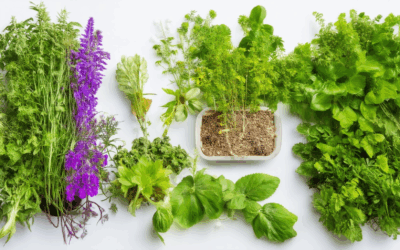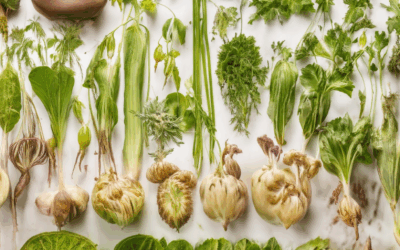Healthy soil is the cornerstone of any successful garden or landscape, providing essential nutrients and support for plants to thrive. Among the most effective ways to enhance soil quality is through sustainable soil enrichment, a practice that prioritizes eco-friendly methods to improve soil health while minimizing environmental impact. Whether you’re working with a small urban garden or a sprawling property, understanding the best approaches to enrich your soil can lead to more vibrant growth and a more resilient ecosystem. In this article, we’ll explore various methods, products, and expert tips to achieve sustainable soil enrichment, as well as delve into the debate between compost and topsoil to determine which option best suits your needs. By adopting eco-conscious practices, you’ll not only improve your soil’s fertility but also contribute to a healthier planet for future generations. Let’s dive into the ins and outs of sustainable soil enrichment and discover how it can transform your gardening efforts.
Key Takeaways
– Understanding Soil Enrichment: Enhances soil fertility and structure using organic materials and customized techniques for optimal lawn health.
– Benefits of Soil Enrichment: Boosts plant growth, improves nutrient availability, and supports long-term soil health through better pH balance and reduced compaction.
– Key Ingredients: Includes composted poultry manure, humate, and seaweed extract for sustained nutrient release and microbial activity.
– Effective Application: Involves soil analysis, timely application (ideally late spring or early fall), and even distribution to maximize effectiveness.
– Choosing the Right Service: Offers expert solutions and high-quality products to achieve a resilient and vibrant lawn.
– Compost vs. Topsoil: Complement both for optimal results—compost enhances fertility while topsoil improves structure.
– Improving Lawn Soil: Address issues through aerating, adding organic matter, adjusting pH, dethatching, and proper watering for healthier grass roots.
– Fertilization and Monitoring: Use soil tests to tailor fertilizers and regularly monitor soil health for sustained improvements.
What is Soil Enrichment?
Soil enrichment is a process designed to enhance the health and fertility of soil, ensuring it becomes more productive and capable of supporting robust plant growth. This method focuses on improving soil structure, nutrient availability, and overall soil quality, which directly benefits gardens, lawns, and agricultural fields.
Overview of Soil Enrichment
Soil enrichment typically involves adding organic matter, amendments, or other materials to the soil to improve its properties. By doing so, it increases water infiltration, reduces compaction, and enhances microbial activity, leading to better root development and plant health.
Benefits of Soil Enrichment
- Improved Fertilizer Efficiency: Enhances the absorption and utilization of nutrients by plants, making fertilizers more effective.
- Stronger Root Systems: Healthier roots enable plants to better withstand stressors like drought, pests, and diseases.
- Increased Yield: Better nutrient availability leads to higher crop yields and more vibrant vegetation.
- Enhanced Soil Structure: Reduces soil compaction and improves drainage, allowing for better root penetration and oxygenation.
Methods of Soil Enrichment
- Organic Matter Addition: Incorporating compost, manure, or mulch to boost soil organic content and promote microbial activity.
- Amendment Application: Using lime, gypsum, or other soil amendments to adjust pH levels and improve nutrient availability.
- Aeration Techniques: Tilling the soil or incorporating porous materials like sand to improve airflow and reduce compactness.
- Water Management: Implementing practices like rainwater harvesting or drip irrigation to optimize water usage and soil moisture retention.
Considerations for Effective Soil Enrichment
- Testing and Monitoring: Conduct soil tests before applying amendments to understand current conditions and target improvements effectively.
- Application Timing: Apply enrichments during planting or before sowing seeds for maximum benefit.
- Method Selection: Choose techniques suited to your soil type and growing needs, whether residential, commercial, or agricultural.
- Professional Consultation: Consulting with experts or local agricultural services can provide tailored advice for specific soil challenges.
Examples of Successful Soil Enrichment
Many farmers and gardeners have achieved remarkable results through consistent soil enrichment. For instance, Lawn Doctor emphasizes the use of specialized treatments to enhance lawn health, while GreenSpace Solutions offers comprehensive soil analysis and enrichment packages for commercial applications.
By investing in soil enrichment, you can create a more productive growing environment, ensuring better crop yields and healthier plants year after year. Always apply treatments carefully and consider professional guidance to maximize outcomes.
Best Way to Enrich Soil
To enrich your soil effectively, consider the following organized approach:
1. Incorporate Organic Matter
- Add compost or aged manure to improve texture and nutrient content.
- Use mulch to retain moisture and suppress weeds, enhancing soil health over time.
- Apply worm castings or fish emulsion for micronutrients and beneficial bacteria.
2. Practice Proper Tillage
- Loosen compacted soil to increase airflow and root penetration.
- Turn under green manure or crop residues to recycle nutrients back into the soil.
- Use tools like a shovel or plow to aerate the soil before planting.
3. Implement Composting
- Start a compost pile with kitchen scraps, yard waste, and animal manure.
- Water regularly and turn the pile to accelerate decomposition.
- Apply compost to your garden beds before planting to boost fertility.
4. Utilize Cover Cropping
- Plant nitrogen-fixing crops like clover or alfalfa to enrich the soil.
- Rotate crops to prevent soil depletion and promote biodiversity.
- Harvest the cover crop in the fall to add organic material to your soil.
5. Test and Adjust pH Levels
- Use a soil test kit to determine pH and nutrient levels.
- Adjust the soil accordingly based on your plants’ needs and local conditions.
- Consider adding sulfur or lime to adjust acidity or alkalinity as needed.
Additional Tips for Soil Enrichment
- Apply mulch annually to protect soil and retain moisture.
- Minimize tillage to preserve soil structure and organic matter.
- Plant native species that enhance soil health and sustainability.
By following these methods, you can create a thriving environment for your plants and ensure long-term soil fertility. For more detailed guidance, explore our composting guide and other resources on improving soil health.
Best Soil Enrichment Products
When it comes to enhancing your garden’s soil, selecting the right amendments is crucial for maximizing growth and productivity. Here’s a curated list of top-rated soil enrichment products:
- Compost : Rich in organic matter, compost improves soil structure, water retention, and nutrient availability. It’s perfect for gardens and outdoor plants.
- Worm Castings : A concentrated source of nutrients, worm castings boost microbial activity and promote healthy plant growth.
- Leaf Mold : Decomposed leaves provide humus, enhancing soil fertility and moisture retention over time.
- Biochar : Known for its ability to sequester carbon and improve soil health, biochar acts as a long-term soil conditioner.
- Azomite : A natural mineral supplement rich in micronutrients, azomite enhances soil health and promotes strong root development.
- Dolomitic Limestone : Provides essential calcium and magnesium, which strengthen plant cell walls and improve soil pH balance.
- Gypsum : Adds sulfur and calcium, helping plants absorb trace minerals and improve overall soil structure.
- Greensand : A mineral amendment rich in iron, greensand adds color and nutrients to the soil, making it ideal for ornamental plants.
- Dr. Earth’s Organic Soil Builder : A premium blend of compost and minerals, Dr. Earth’s product supports healthy plant growth and sustainable gardening practices.
- Garden of Eden Organic Compost : Made from sustainably sourced materials, this compost is excellent for improving soil texture and nutrient levels.
These products work synergistically to enrich your soil, ensuring healthier plants and a more productive garden. Consider testing a few to see what works best for your specific needs.
What is Soil Enrichment by a Lawn Doctor?
Soil enrichment is a vital process for achieving a healthy, thriving lawn. Our specialized service focuses on enhancing your soil’s fertility and structure through carefully selected organic materials and advanced techniques tailored to your lawn’s needs.
Benefits of Soil Enrichment
- Improved Plant Growth: Richer soil leads to stronger root systems and healthier grass, ensuring your lawn thrives under stress and adverse conditions.
- Enhanced Nutrient Availability: By introducing essential nutrients, our soil enrichment service ensures your lawn receives the necessary elements for robust development.
- Long-Term Soil Health: Regular enrichment helps maintain optimal soil pH levels, promotes microbial activity, and reduces compaction, leading to better drainage and root penetration.
Key Ingredients in Our Soil Enrichment
- Composted Poultry Manure: Provides a slow-release supply of nitrogen, phosphorus, and potassium, enriching your soil over time.
- Humate: Acts as a natural bio-stimulant, enhancing microbial activity and promoting plant growth.
- Seaweed Extract: Improves soil structure, increases water retention capacity, and supplies essential micronutrients.
How Soil Enrichment is Applied
Our professionals conduct a thorough soil analysis before applying the enrichment mixture. The treatment is typically done in late spring or early fall, ensuring maximum absorption and effectiveness. We distribute the materials evenly across your property, ensuring proper integration with existing soil layers.
Why Choose Our Soil Enrichment Service?
Investing in our soil enrichment program is a smart decision for any homeowner looking to achieve a lush, green lawn that withstands environmental challenges. By working with us, you gain access to expert knowledge and high-quality products designed to deliver measurable results.
Ready to transform your lawn? Contact us today to schedule your soil enrichment service and take the first step toward a more beautiful and resilient landscape.
Is Compost or Topsoil Better for Grass?
Both compost and topsoil have unique benefits for grass, depending on your specific needs and goals. Here’s a breakdown:
- Compost: Ideal for improving soil fertility, water-holding capacity, and supporting microbial activity. It enhances nutrient availability and promotes healthier grass growth over time.
- Topsoil: Provides a balanced mix of nutrients and improves soil structure, making it effective for leveling uneven areas and creating a stable base for grass.
For optimal results, consider combining both materials. Apply compost to enhance soil health and nutrients, then layer topsoil to improve texture and structure. This blend can provide both immediate and long-term benefits for your lawn.
How to Fix Bad Soil in Your Lawn
To address poor soil conditions in your lawn, follow these organized steps for improvement:
- Aerate the Soil : Use a garden fork or aeration tool to create holes in the soil. This improves drainage and allows roots to access oxygen and nutrients more efficiently.
- Add Organic Matter : Incorporate compost or well-rotted manure to enhance soil structure and fertility. Mix approximately 1-2 inches of material into the soil, avoiding direct contact with plant stems.
- Adjust pH Levels : Test the soil pH using a simple kit. If it’s too acidic, apply lime; if too alkaline, use sulfur. Follow application rates recommended by the test kit.
- Dethatch the Lawn : Remove excess thatch using a dethatching tool or rake. This prevents suffocation of grass roots and allows sunlight, water, and nutrients to penetrate the soil.
- Improve Water Infiltration : Ensure the soil isn’t waterlogged by adjusting irrigation systems or using rainwater collection. Proper watering promotes healthy root growth without causing soil compaction.
- Fertilize Appropriately : Conduct a soil test to determine exact nutrient requirements and apply a balanced fertilizer accordingly. Avoid over-fertilizing to prevent soil degradation.
- Monitor and Maintain : Regularly check soil health by observing its texture and appearance. Early intervention can prevent minor issues from becoming major problems.
By systematically addressing these aspects, you can transform poor soil into a thriving environment for your lawn, ensuring stronger growth and healthier plants.








0 Comments